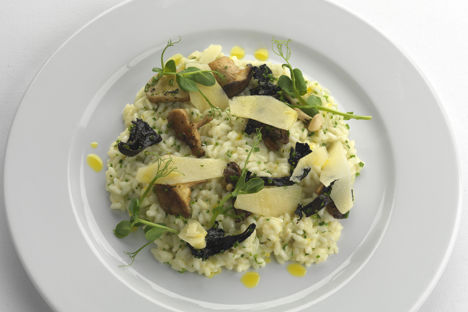Parmesan is an ingredient that many chefs and cooks cannot do without. Whether being used to finish a risotto, make biscuits or simply to scatter over pasta, its nutty, fruity and intensely rich flavour excels and enhances a wide variety of dishes.
But many of us are not exploring the possibilities of Parmesan as much as we could be. Because there’s much more to this centuries-old artisan cheese than you might imagine.
What to look for when buying Parmesan
Before we get to the fun stuff, it is worth considering some things to look out for when purchasing Parmesan.
Firstly, it is important to recognise that Parmigiano Reggiano is the only Parmesan. It is a Protected Designation of Origin (PDO) product, meaning that its distinctive features and its link with the area of origin are guaranteed by a system of EU rules. ‘Parmigiano Reggiano’ is applied as a mark of origin onto the rind of the cheese which assures quality and traceability. Look out for the Parmigiano Reggiano and PDO guarantee marks displayed on pre-portioned cheese.
Another thing to consider is the maturity of the cheese. Age is key with Parmesan – the minimum ageing period is 12 months, but can continue for 24 months or more, during which time the cheese develops its flavour, texture and digestibility. Parmigiano Reggiano aged for 30 months and more is drier and crumbly, and has a more nuanced and distinguished taste.
Note: Parmesan contains animal rennet and is therefore not vegetarian.
The temperature at which it is stored can affect the flavour profile of Parmigiano Reggiano. Once opened, try to store between 4 and 8°C. Whole Parmesan should not be frozen as it does not react well to low temperatures – though, grated Parmesan can be frozen.
For optimum preservation, Luke Holder advises storing Parmesan whole and vacuum-packed in the fridge, recommending that cooks “use it fresh for the first two weeks then only for grating into risottos for a further four weeks after that”.
What Parmesan goes with
It almost goes without saying that grated Parmesan kept in a tub or packet is not an ideal way to preserve the cheese – Parmesan starts to lose a lot of its wholesome flavour after being grated. With its special texture, aroma and exceptional taste, there are many ways of getting the best of out this Italian hard cheese. Luke Holder recommends using Parmigiano Reggiano to dress warm new potatoes, rice, pasta or even polenta. In addition, by mixing Parmesan with soft butter and breadcrumbs it can be used to add a crust to veal chops or other meats and some fish.
Parmesan can be equally effective served on its own or as one part of an antipasti board. Parmesan matches superbly with other Italian ingredients – balsamic, Parma ham, bresaola – but don’t let that restrict you.
Get in touch
Please sign in or register to send a comment to Great British Chefs.



